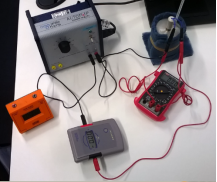Aluminium Heat Capacities
| ✅ Paper Type: Free Essay | ✅ Subject: Physics |
| ✅ Wordcount: 632 words | ✅ Published: 11 Sep 2017 |
Aim
The aim of the experiment was to determine the specific heat capacities, with uncertainties, of two different materials; for the purposes of this experiment, it was chosen to be aluminium
Introduction
Specific heat capacity is defined as the quantity of heat energy, which will raise the temperature of unit mass (1kg) of a substance by 1K. It is usually denoted by c and expressed in J/(kg.K). (Joule per kilogram Kelvin).
So, what is the relationship between heat and temperature?
It is usually expressed ΔQ = m c ΔT Heat energy = mass x specific heat capacity x temperature change, (c) being the specific heat capacity. The relationship will not happen if there is a phase change due to heat either being added or removed, does not change the temperature
ΔQ to the change of temperature ΔT is given by: ΔQ = m c ΔT Where ΔQ = the change in heat energy. is the enthalpy, m = the mass c = specific heat capacity ΔT = the change of temperature. Unit: Jkg-1K-1.
High specific capacities occur in substance that take a lot of heat energy and therefore have a long time to heat or cool down. The specific heat capacity of the sea is much greater than the land, so therefore more heat energy will be needed to heat it up by the same amount as the land. From the relationship: mass x specific thermal capacity x temperature / time = current (amps) x p.d. (volts) .The ratio temperature rise or time can be gotten from the graph slope of temperature which was plotted against time and this is how thermal capacity can be met.
Hypothesis
Can the chosen method of investigation produce a reliable value for the specific heat capacity of a metal block?
 Method
Method
Apparatus: Calibrated thermometer
power pack, Stop clock, Voltmeter
Leads, Balance (up to 1kg),
Ammeter, Immersion heater Test metals
Heat proof matt and lagging
The immersion heater was connected to the power pack, which was set to 10V. The voltmeter and ammeter were set up so that they measured the potential difference and current going through the heater. Next the mass of the sample was recorded using the balance and the immersion heater was placed in the test sample, followed by the thermometer and an initial temperature reading. Simultaneously the power pack was turned on and the stop clock started, and the heater was left to run for two minutes prior to the first recording. Recordings were taken from the voltmeter and ammeter every minute for a total of 15 intervals. The collected data was gathered into a table with the following headings: Following this the data was used to produce a graph of energy against temperature difference, from which the specific heat capacity can be determined.
|
Original mass: 987.8g |
x-axis |
Original temperature, T1: 20oC |
Y-axis |
||
|
Temperature, T2 |
Temperature change, T2-T1 |
Voltmeter, V |
Ammeter, A |
Time, s |
Energy, J |
|
26 |
6 |
11.16 |
4.15 |
120 |
5557.68 |
|
27 |
7 |
11.18 |
4.12 |
180 |
8291.09 |
|
30 |
10 |
11.17 |
4.16 |
240 |
11152.13 |
|
33.5 |
13.5 |
11,16 |
4.15 |
300 |
13894.20 |
|
37 |
17 |
11.13 |
4.18 |
360 |
16748.42 |
|
40 |
20 |
11.13 |
4.19 |
420 |
19586.57 |
|
43 |
23 |
11.14 |
4.20 |
480 |
22458.24 |
|
46.5 |
26.5 |
11.13 |
4.22 |
540 |
25363.04 |
|
49.5 |
29.5 |
11.15 |
4.21 |
600 |
28164.90 |
|
52.5 |
32.5 |
11.15 |
4.21 |
660 |
30981.39 |
|
55.5 |
35.5 |
11.13 |
4.23 |
720 |
33897.53 |
|
58.5 |
38.5 |
11.12 |
4.23 |
780 |
36689.33 |
|
62 |
42 |
11.13 |
4.23 |
840 |
39547.12 |
|
64.5 |
44.5 |
11.12 |
4.24 |
900 |
42433.92 |
|
67.5 |
47.5 |
11.11 |
4.22 |
960 |
45008.83 |
|
70.5 |
50.5 |
11.11 |
4.24 |
1020 |
48048.53 |
Results Table 1:
See graph 3 for a plot of Energy, Q against the temperature difference,  T. From this graph the gradient will be determined and the specific heat capacity for the metal found.
T. From this graph the gradient will be determined and the specific heat capacity for the metal found.
Gradient of graph 3: 
 units:
units: 
 units:
units: 
Specific heat capacity of the metal:
 units:
units: 
 units:
units: 
Conclusion
The hypothesis of “Can the chosen method of investigation produce a reliable value for the specific heat capacity of a metal block?” has been met ,more will be said and evaluated below.
Evaluation
Accuracy can be improved by the method of conducting several iterations of the experiment to gather enough information to produce a mean value for the specific heat capacity. Furthermore, the temperature was recorded using a liquid in glass thermometer with an accuracy of +/- 0.5 this lead to percentage errors in the temperature readings ranging from 2.5%- from
this lead to percentage errors in the temperature readings ranging from 2.5%- from  In order to reduce these errors future experiments will be carried out using more accurate thermometer.
In order to reduce these errors future experiments will be carried out using more accurate thermometer.
Cite This Work
To export a reference to this article please select a referencing stye below:
Related Services
View allDMCA / Removal Request
If you are the original writer of this essay and no longer wish to have your work published on UKEssays.com then please click the following link to email our support team:
Request essay removal


